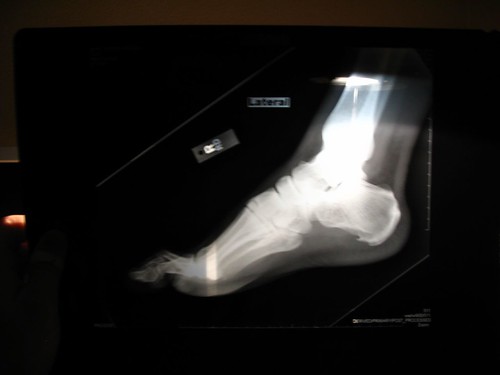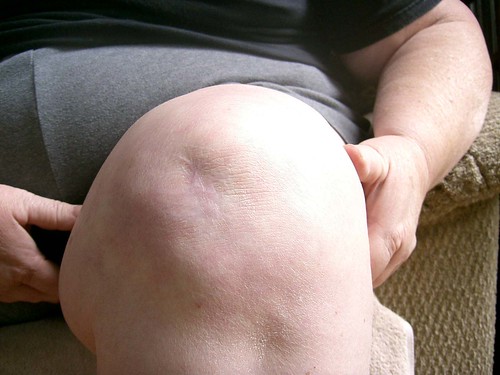UPDATE: Make that 11.
We’ll start with the 11th, because since I wrote this post originally I now think it’s one of the most important. Fitness, health and recovery is often a contentious area and one where opinions and facts change constantly. Thanks to advances in science and research, the best people to turn to are always the ones that keep their minds open and objectively look at all of the facts.
11. Self Soft Tissue Work
 We touch on foam rolling later in the article, but it is very important that you are doing your own soft tissue work. Getting a tennis ball and smashing those structures around the knee is single handedly the easiest and most effective way to get rid of a lot of knee pain. The tennis ball is my favourite, because everyone has one.
We touch on foam rolling later in the article, but it is very important that you are doing your own soft tissue work. Getting a tennis ball and smashing those structures around the knee is single handedly the easiest and most effective way to get rid of a lot of knee pain. The tennis ball is my favourite, because everyone has one.
You can work through all your quadriceps muscles very effectively on your own. Lying on the floor on your stomach, with the ball under your thighs. You can move your body up and down until you find points of interest, otherwise known as trigger points. If you don’t find any of these, then keep on working. Chances are you have some tight structures which really need to be worked out.
Your quads aren’t the only area that need addressing. Working on your TFL, ITB Adductores, Calves and even your hip flexors can help resolve a lot of generic knee pain. If you don’t know what these are or how to release them, don’t stress. You can pick up a copy of the Ultimate Self Massage Guide and work through those areas with a tennis ball and foam roller.
Now, back to the original article.
Knee pain is one of the most common ailments people report when exercising. Everyone is putting their knee joint under stress regularly, especially those participating in exercise and lifting. The good news is, there are so many things you can, and should be doing to prevent it. Read on for some tips on how to keep your knees healthy and pain free (in no particular order).
1. Warm Up Correctly
Warming Up is one of the simplest things you can do to prevent your knees from deteriorating. A good dynamic warm up gets the synovial fluid going in your joints. Meaning a lot less friction during your workout. Just because you have no pain now, or think you are young and can jump on the squat rack straight away, be careful. Your knees absorb a lot of force during a workout, make sure they are ready.
2. Posterior Chain Function: It Ain’t Pretty But You Need It
I know I am starting to sound like a broken record, but your posterior chain is so important. Lose hip function, and you lose your powerhouse, your core stabilizer and your ability to perform most movements correctly. Proper hip function goes a long way to easing knee pain. You can take more of the force from the knee during many exercises and movements. Weak hips also means you are unable to control the femur as well as you should, and can lead to stability issues at the knee, and as above, bad biomechanics leading to extra force through the knee.
Most people are very quad dominant; however for example, your butt should lift very large percentage of the weight when you squat. Problem is, a lot of us have trouble activating it. Start working on your hip function, and ensure it is part of every leg workout. Get into some activation exercises such as:
- Glute Lifts


- Bridges (Can be done on or off a swiss ball)
There are many out there to choose from, just start adding some into your warm-up, this will get them fired up for the hard glute session I know you have planned. Once you have learnt to activate them a bit better, and have more strength, you will find during most exercises (such as lunges and squats) you will be using a lot more glute.
Two more important points on glute activation
- Remember when you squat to think of drifting your hips back first. It’s the absolute first movement you want to do. This will automatically engage your glutes.
- Make sure you are regularly stretching your hip flexors; these babies can get very tight and will affect your glutes ability to fire.
Don’t forget about your hamstrings. These fellas also need some work…balance your training…they aren’t the most glamorous muscle, but getting them as strong is necessary and should not be neglected. It is very common to see people doing 3 quad dominant exercises to one hamstring/glute one. A properly functioning posterior chain isn’t going to scare the pants off people like some big massive quads will, but what is the point in having those quads if by 35 you are unable to half squat anymore?
3. Get Some Ankle Mobility

Pic: Steve Burt
Yes, your ankle function has a lot to do with your knee health. A lot of people have very poor ankle mobility, and as a result have some pretty crappy biomechanics during their workouts and heavy lifts. If you find your ankles are limiting your ability to perform certain movements, then they are probably limiting your knees ability to absorb and transfer force correctly. Scrap that, they are definitely transferring unwanted force through the knee joint. You may have flexibility issues from tight calves, or mobility issues from an existing ankle injury. Either way, ankle mobility is easy to fix.
- Start standing with your feet a few cm away from the wall.
- Keep your heels on the ground and try to touch your knee to the wall.
- Repeat a few times, each time you touch the wall, step back a little.
- Stretch your calves regularly if you are tight.
You will find you get great increases in your flexibility and mobility quite quickly.
4. Hip Mobility: Is Yours Good Enough?
This is a similar deal to ankle mobility. Poor hip mobility leads to some bad biomechanics during movements. You only have to look at someone with bad hip mobility squat. Straight away they want to bend more at the knees, and end up with their weight forward. This causes a lot of stress through the knee joint. The best way to squat is with your hips first; lack of hip mobility hinders this. I use the squat as an example because it is a very functional movement that most of us have to perform (and will do so with a fair bit of weight on your back if you do any sort of good strengthening program). However these principles apply to everyday life and other activities. Get into some hip mobility work, couple this with glute strengthening and you will have some fully functional hips. This is going to greatly decrease your chance of getting knee pain. Check out this post from Volleyball Base for some hip mobility work.
5. Lateral Vs Medial Knee Structures…The Truth

too much VMO work…? Pic: basykes
VMO is a term that is thrown around willy nilly these days in regards to knee pain. It is very true that a lot of knee pain is caused by imbalances between the lateral and medial structures of the knee. Your lateral structures (vastus lateralis/ ITB) are generally stronger and tighter than your medial structures (VMO), and will exert a force on your knee cap, pulling it laterally. Isolating your VMO is hard. You can activate it more in some exercises, but in a relatively healthy knee it’s generally being used during movements you are doing anyway i.e the Squat. End range knee extensions will hit the VMO, but it won’t isolate it. (Serious knee injuries and rehabilitation are a different story…more of this work is needed but still, you cannot isolate the VMO completely. As soon as you have an injured knee, the VMO is one of the first things to shut off. Often in these cases you will require some VMO activation work. In a healthy knee however, you will tend to activate it well in most quad exercises).
So if we can’t isolate the VMO and you have a healthy knee and a normally functioning VMO, then you should probably focus on the other side of things. Loosening our lateral structures. How? Foam rolling. The easiest and simplest thing you can do for yourself regarding soft tissue work. ITB and lateral quad are general very tight in people. Roll on the foam roller often, loosen these structures, and reduce the amount of pull these structures exert on your kneecap. Prevent pain…start rolling.
6. Supplement Your Diet
If you are an athlete, a weight lifter, a body builder or a gym goer, chances are you are putting your knees under some stress that simply can’t be avoided. There are some supplements out there that can help. These are yet to be 100% proven to prevent joint pain, but the research so far looks very very good, and there are little to no side effects. These basically risk free, joint protecting supplements are looking good, and if you are lifting heavy loads, it is definitely worth taking them.
- Take 1500mg Glucosamine and 1200mg Chondroitin Daily (More information check out this site)
- Get into Fish Oil Supplements – They have an anti inflammatory effect on joints, not to mention all the other wonderful benefits.
7. Get Better Technique
Most of the time it’s not the exercise that’s hurting your knees, it’s the way you are doing it. I mentioned it before, but if you aren’t drifting your hips back in the squat initially, you probably aren’t getting the hip activation you need, and thus more stress through your knees. Technique is important, but it is hard to know whether you are spot on or not.
You may have bad technique because you have bad ankle or hip mobility, or it may be as simple as you haven’t been taught the right way. From the start, learn how to lift correctly. You will take a big load off your knees and will go a long way to preventing knee pain in the future. If you are unsure about your technique, check with a trainer, or get someone in the know to give you some feedback.
8. Maintain A Healthy Weight

Pic: Mandj98
This one may seem like a simple concept, but it really does hamper your ability to be pain free in the knee. The heavier you are, the more stress you are going to put through the knee joint. It’s simple. Maintain a healthy weight, and you will keep your joints from carrying too much throughout everyday activities, and thus, lower your chances of getting knee pain.
9. If It Hurts…Stop
If you have knee pain, and something is hurting it, stop it. There’s always a better way to do it or something else to do instead of it. Most likely whatever it is, could be causing you more pain, damage and degeneration. Don’t stop forever though, figure out the problem, and slowly integrate it back into your training. When you are injured, you simply aren’t doing your body any good, and you really aren’t going to get the benefits you wanted anyway.
10. Recover and Stretch, Just Do It

Pic: Photocapy
Tight structures surrounding the knee can be a cause of knee pain. Different muscles pulling at different angles can wreak havoc on your knee. Stretch your Quads, hip flexor, Calves, Glutes, ITB’s and Hamstrings after ever every session. You need them to relax after a session, stretching is the simplest thing you can do for that.
Pay attention to your recovery. These muscles need to recover to work optimally. Fatigued muscles aren’t going to be much help stabilizing your knee and transferring force correctly. Optimally functioning muscles will give you much more chance at fighting and preventing knee pain. It’s simple, so just do it.
If you want more information about treating your knees yourself, then you should check out this book, The Ultimate Self Massage Guide.
Conclusion
Knee pain is an unnecessary hiccup that does affect many lifters, athletes and everyday gym goers. Take some of these tips and put them into practice even if you aren’t suffering from knee pain yet. Chances are, by not doing these things you are setting yourself up for some pain in the future. This is definitely not all you can do to prevent knee pain, but they are some of the more important ones…do you have any more tips?

Awake In Rochester says
Thanks for the ideas. I try to eat fish high in omega fats like salmon 2 times a week.
Melanie says
Thanks for this article; it’s really good. I’m having minor knee problems right now, and I don’t have health insurance and can’t afford a doctor. Yes, I know your article is for information purposes only. 🙂 But it really does help. The exercises and ideas presented here combined with my being more aware of how I use my knee in everyday life will go a long way toward helping me out.
Thanks again! Please let me know if you ever do any more articles on knee pain/sports injuries to the knee (especially the impact of martial arts on the knees).
Amy William says
Hi Melanie,
I read your comment and I would like to say that yoga with proper diet is best option for you. But still you need to go to a doctor to know what are the causes for your keen pain. As their are different reason for it. Might be you are suffering from minor pain but may be it will be the 1st stage of any other problem. Please go through this article and get information why someone suffer from knee pain. http://painclinic.sg/category/what-are-the-common-causes-of-knee-pain.htm
Lauren says
Cheers Melanie, just sent you en email.
Isabelle Gonzales says
Healthy weight is easy to maintain, just watch your diet and always exercise.’:’
Tumble Dryers ` says
healthy weight may not be achieved easily if you are very lazy to exercise;`,
L-Lysine Dosage : says
actually, it is easy to get a healthy weight if people are just careful on what they are eating*”*
Gabrielle Lopez says
Thanks so much, I am a dancer, and there is a lot of thing that you said here that I have done and it’s true, I just did not know, about that, but your tips are going to help me, and the glucosamina really has help me
lose weight says
I like you website. I’m looking for ways to stay trim and keep the weight down.
Imelda Anselmo says
Correct exercises goes along with proper diet and healthy lifestyle, enough rest and sleep. But it’s a good guidelines though.
buy pinterest followers says
I¡¦ve recently started a blog, the information you offer on this web site has helped me tremendously. Thank you for all of your time & work.